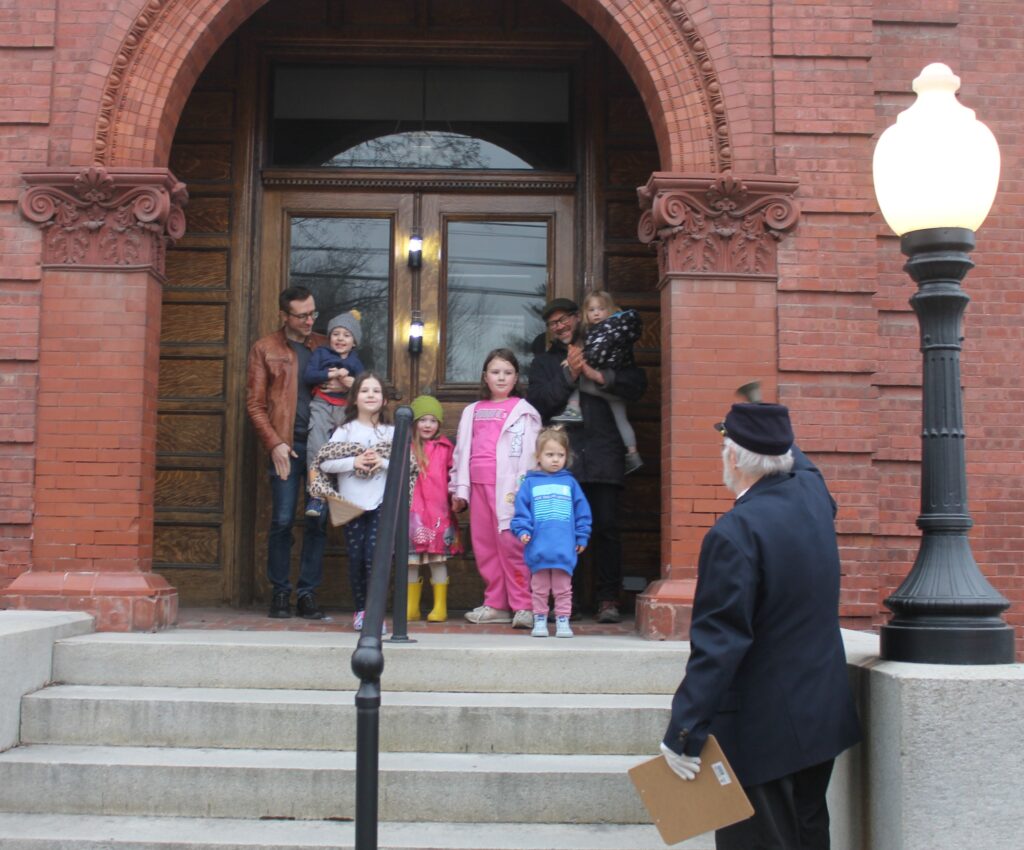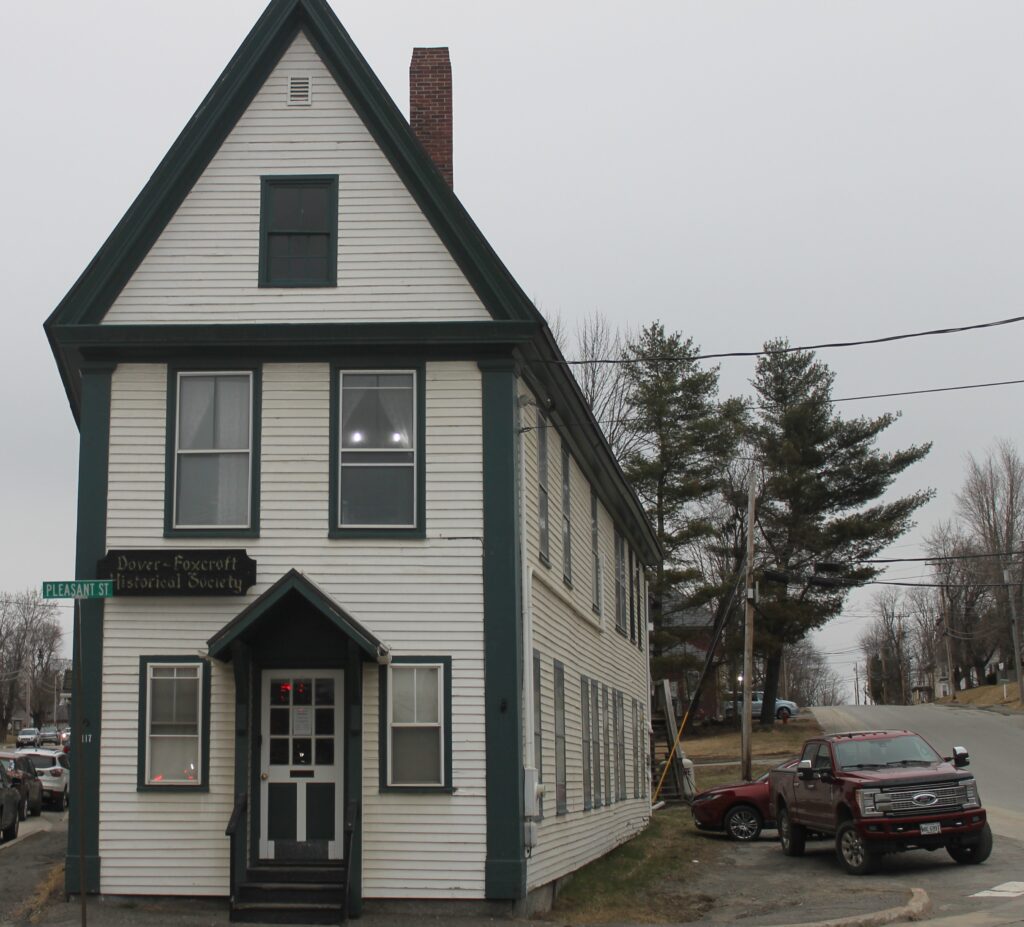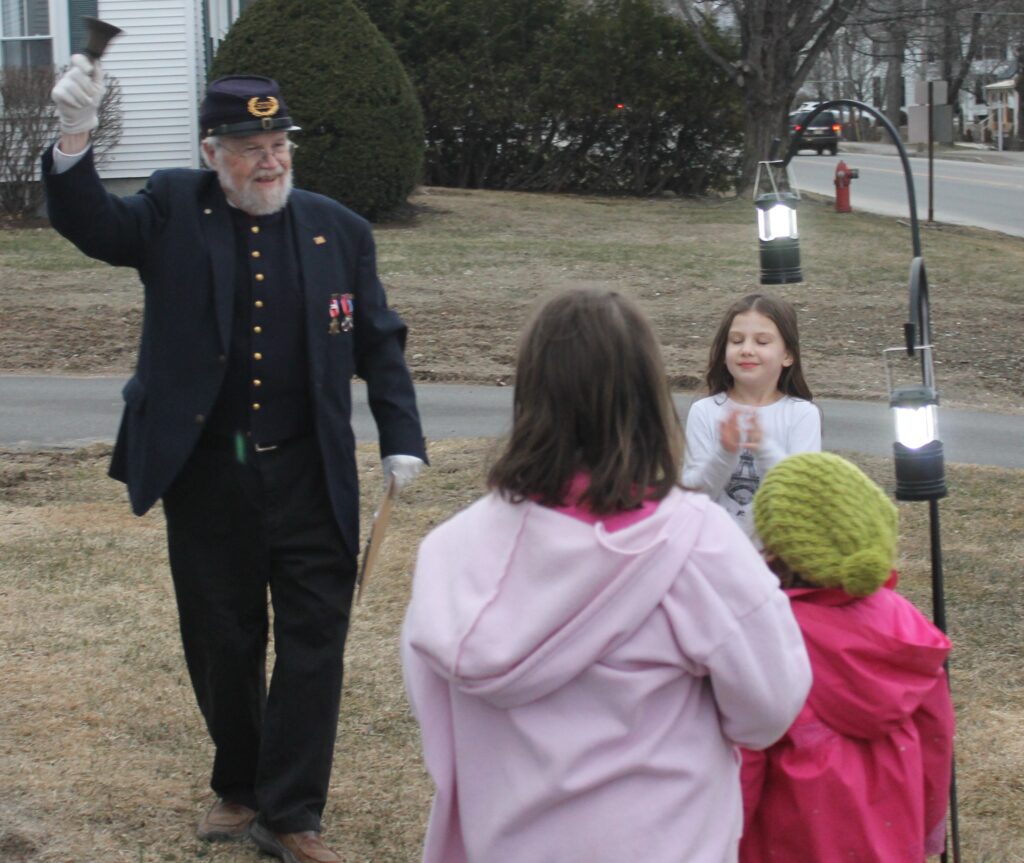
Two lights commemorate the beginning of America’s birth
DOVER-FOXCROFT — Exactly 250 years after two lanterns were hung in Boston’s Old North Church to signal Paul Revere and spark a chain of events that began the American Revolution, the town of Dover-Foxcroft joined communities across Maine and elsewhere with the “Two Lights for Tomorrow” event commemorating the anniversary during the early evening of April 18.
By the front steps of the Thompson Free Library on East Main Street, Eric Boothroyd of the local chapter of the Sons of Union Veterans called the attendees to order with a ringing of his hand bell.
He explained that on the night of April 18, 1775, two lanterns were hung in the tower of Boston’s Old North Church as a signal to Revere, across the river in Charlestown, that the British regulars were moving “by sea” across the Back Bay to Cambridge to begin their march to seize powder and munitions in Concord. This signal sparked a chain of events that led to the confrontations at Lexington and Concord the following day, the beginning of the American Revolution and the ultimate birth of the nation.

TWO LIGHTS FOR TOMORROW — A pair of lanterns are placed on the front door of the Thompson Free Library in Dover-Foxcroft on April 18 for “Two Lights for Tomorrow”. The nationwide initiative commemorates the night of April 18, 1775 when two lanterns were hung in the tower of Boston’s Old North Church as a signal to Paul Revere, across the river in Charlestown, that the British regulars were moving “by sea” across Back Bay to Cambridge in order to begin their march to seize powder and munitions in Concord. This signal sparked a chain of events that led to the confrontations at Lexington and Concord the following day, the beginning of the American Revolution and the ultimate birth of the nation.
“Two hundred and fifty years later we commemorate this event with ‘Two Lights for Tomorrow,’” Boothroyd, dressed in a replica Civil War-era uniform, said.
The nationwide initiative uses the imagery of the two shining lights as a uniting call to action to fellow citizens, no matter where they are, to recognize and remind that history is about working together for a promising future.
The word “free” in the name of the library is appropriate, Boothroyd said, as everyone is free to pursue their own interests with the information inside.
Nancy Battick of the Daughters of the American Revolution and Daughters of Union Veterans then read Portland-born Henry Wadsworth Longfellow’s 1860 poem “Paul Revere’s Ride.”

TWO LIGHTS AT THE MUSEUM — A pair of lights were turned on at the Dover-Foxcroft Historical Society’s Observer Building Museum for “Two Lights for Tomorrow” from the evening of April 18 through the following morning.
After Battick concluded the poem, Boothroyd said the Thompson Free Library is a source of youth engagement as several young volunteers came forward to help hang a pair of lanterns on the front door.
“We place these two lights here as the free flow of information and expression are a right in this country,” Boothroyd said.
The “Two Lights for Tomorrow” procession moved down East Main Street to the Central Hall Commons, the second of four destinations. The late 19th century building, renovated into a community space in the 21st century, is a symbol of local government, Boothroyd said.
Past generations of residents would gather to vote and make decisions on the town’s future in acts of self-governance, he said. Soon a pair of upstairs lights in the windows were turned on.

TOWN PROCLAMATION — Dover-Foxcroft Selectperson Emery Cox, joined by board members Jane Conroy, left, and Cindy Freeman Cyr, reads a town proclamation for “Two Lights for Tomorrow” on April 18 outside the Dover-Foxcroft Congregational Church.
A short distance to the west is the Dover-Foxcroft Historical Society’s Observer Building Museum. “A reminder of our history,” Boothroyd said.
In 1775, the spot everyone was standing on was part of Massachusetts, Boothroyd mentioned. He said Patriots Day is celebrated in just Maine and Massachusetts as thousands of citizens of the land that would become the two states answered the call 250 years prior to come together for a cause they believed in.
The lights displayed for the event on April 18 were to remain illuminated into the following morning, recognizing Revere’s famous ride from Charlestown to Lexington, Massachusetts, warning colonists that British Regular troops were approaching to the next day when the American Revolutionary War began with the Battles of Lexington and Concord — the start of an eight-year armed conflict between American colonists and the British Army.
The final stop of the “Two Lights for Tomorrow” procession was across the Piscataquis River on West Main Street at the Dover-Foxcroft Congregational Church. The house of worship is a symbol of faith and hope, Boothroyd said.

FOR ALL TO HEAR AND SEE — Eric Boothroyd of the Sons of Union Veterans tolls his bell after the final two lanterns for “Two Lights for Tomorrow” were hung on a pole in front of the Dover-Foxcroft Congregational Church on April 18.
“Two lamps in a belfry are a beacon to where we are today,” he said.
Selectperson Emery Cox, joined by board members Jane Conroy and Cindy Freeman Cyr, then read a proclamation from the town for the occasion as the final two lanterns were hung from a pole on the lawn.
“The call to serve each other is no less relevant today than back then,” Boothroyd said. He mentioned the nation’s Semiquincentennial will be July 4, 2026.
As the bells tolled church Pastor Rachel Dobbs gave a benediction.
The Maine Semiquincentennial Commission, chaired by Secretary of State Shenna Bellows, kicked off the celebration of the birth of the United States recognizing Maine’s participation in “Two Lights for Tomorrow”.
“There has never been a more important time to reflect on the hopes, dreams and sacrifices that led to the birth of our country while also reminding ourselves that history is a constantly moving target, and we must continuously work to fulfill, maintain, and further that promised future,” Bellows said in a statement. “From the Battle of Machias to the March to Quebec to the burning of Falmouth becoming a rallying moment, Maine — then a district of Massachusetts — played a key role in the Revolutionary War that led to the birth of the nation. Come forward 250 years to today, and again Maine is playing a crucial role in shaping the future of our country.”
“The image of two lights shining is more than a commemoration of transformational events that occurred 250 years ago, it is a symbol of hope and new beginnings,” said Sarah Hansen, director of Special Projects, Maine State Archives in a statement. “That imagery makes ‘Two Lights for Tomorrow’ a thoughtful and inspiring start to the Semiquincentennial commemoration in 2026, and something that I hope will inspire Mainers to look forward with determination.”